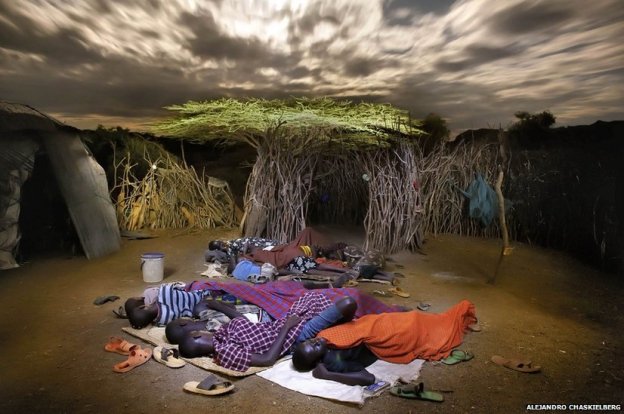This exercise asks that we read the blog post- The Ethics of Aesthetics, writing a comment both on the blog page and in our blog.
This post discusses the worst drought in Africa in 60 years, and explores one specific body of photographic work by Alejandro Chaskielberg that focuses on this plight within the region.
Chaskielberg’s work uses a mixture of flash and moonlight to create a three-dimensional quality that holds great visual appeal. His images blur the lines between reality and fiction; containing a dream like element that depicts the subjects as characters in what could be their own magical dream land. However, do these moonlit images depict the plight of the people accurately?
(1)
(2)
There seems to be a strong sense of contradiction between these calming, magical images, and the realities and struggles of the people in them. The two simply don’t co-inside. For a charity-appeal, these images contain little to no urgency; but only work to make these issues seem almost fictional to the viewer; undermining the message completely.
When discussing aesthetics within images, Martha Rosler states that “The very notion of fundamental ‘aesthetic rightness’ is flawed, and notions of classical beauty lead one away from the real world into an aesthetic eternality.(3)” This highlights the theory that aesthetics within these type of images remove from the real messages that are pleading and crying out to be portrayed.
However, one could argue that whilst Chaskielberg’s images are somewhat unorthodox; they do in fact portray the subject with total dignity. This is something that many other photographers, such as William Willoughby Hooper do not do. But surely there must be a balance between the two? For the subject’s dignity has remained in tact, yet the message has been completely lost in the fiction of the whimsical aesthetics of the image.
I think photographers such as Rankin and Stoddart reach a compromise between the two, as they photograph the issues in a starkly honest, yet beautiful way, but the dignity of the people still remains in tact. Their work portrays the issues honestly and effectively with minimum use of pleasing, yet fake aesthetics to do so. For to truly capture the plight of a subject; one must not worry about the aesthetics of the image, but must simply capture an honest and sensitive interpretation of the subject and the issue outlined. The image below by Rankin underlines the issue of lack of food within South America. It portrays a woman holding an entire days worth of food in her hands. The message is brutal, but the image is beautiful. Thus we see the perfect balance that every photographer should strive to adhere to in order to accurately and effectively portray an issue.
(4)
(1-2) BBC NEWS (2012), In pictures: Combating drought in the Horn of Africa, Available from: http://www.bbc.co.uk/news/in-pictures-16582481 [Accessed 14/08/14]
(3) Grange, Ashley la (2013), Basic Critical Theory for Photographers, Taylor & Francis
(4) THE GUARDIAN (2011), Rankin Photographs Famine in East, Available from: Africa http://www.theguardian.com/commentisfree/gallery/2011/oct/14/kenya-rankin-famine-in-pictures#/?picture=380426311&index=1 [Accessed: 14/08/14]



